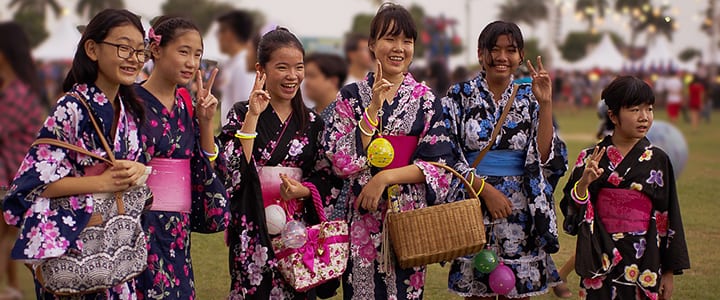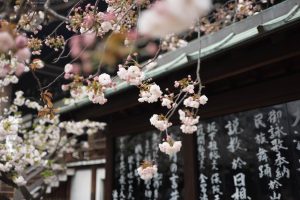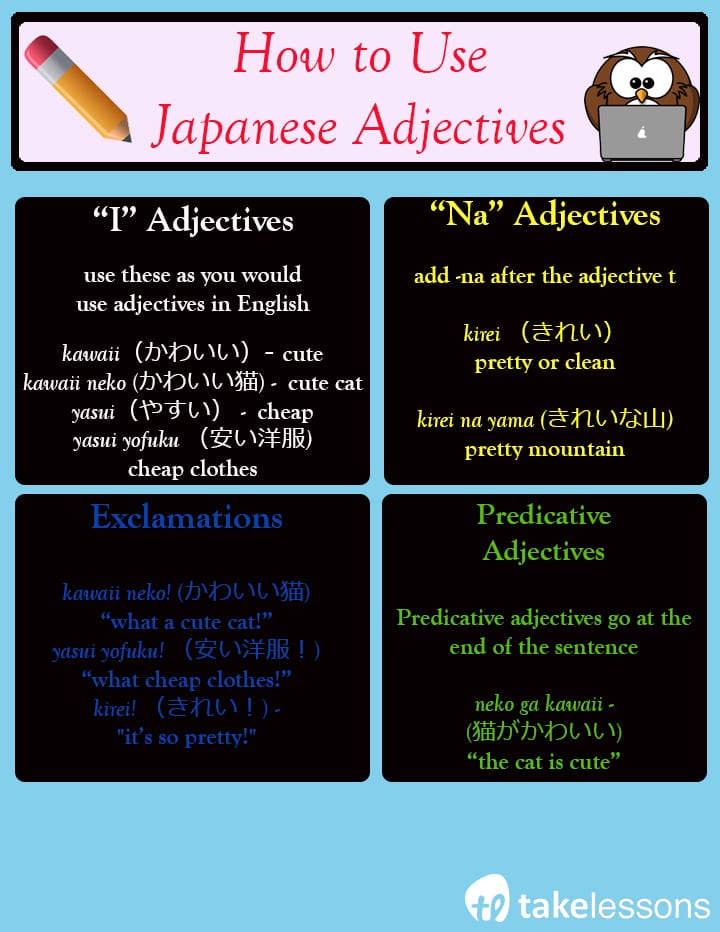Verbs and nouns are vital to form a sentence, but if you want to add some color, you also need adjectives. Here, Ann Arbor, MI teacher Elaina R. shows you how to use Japanese adjectives…
Adjectives are descriptive words.
The stove is hot.
The blue sky turned black.
I am confused.
We use tons of adjectives in our everyday speech. If you’re learning Japanese, learning to use adjectives is a must. Luckily, using adjectives in Japanese is pretty darn easy.
There are only two main types of Japanese adjectives, and they act very similar to English adjectives.
How Do Adjectives Work in Japanese? 3 Key Tips to Keep in Mind
Japanese adjectives are a bit different than English adjectives but they do share some commonalities.
Here are 3 key facts about Japanese adjectives you need to know if you are learning Japanese:
- As is the case with English, Japanese adjectives come before the noun (pretty girl, tall building, etc).
- There are two main types of Japanese adjectives – な-adjectives and い-adjectives.
- All Japanese adjectives (except one) follow the same set of rules. The exception to this is the third type known as a noun-adjective (which is not actually a true adjective but instead a noun that modifies a word).
Japanese Adjective Conjugation Tips
Are you wondering how to conjugate adjectives in Japanese? Here are some basic tips to help you master Japanese adjective conjugation.
- To make i-adjective negative form, drop the “い” and add “くない” to the stem
- In order to turn i-adjective past tense form, drop the “い” and add “かった” to the stem
- To make i-adjective negative past tense form, drop “い” and add “くなかった” to the stem
- In order to turn na-adjective negative form, change “だ” to “じゃない” and change “です” to “ではない.”
- To make na-adjective past tense form, change “だ” to “だった,” or change “です” to “でした.”
- To make na-adjective negative past tense form, change “だ” to “じゃなかった” and change “です” to “ではなかった.”
Adjective conjugation Japanese isn’t always easy, but if you follow the tips listed above, you should be able to get the hang of it with some practice. If you’re still struggling, check out this helpful Japanese adjective conjugation chart and be sure to check out these other online resources for learning Japanese.
How Do You Tell if a Japanese Adjective is “I” or “Na”?
There are two main types of adjectives – “I” and “Na” in Japanese. Usually, “I” adjectives end in the letter “I”. “Na” adjectives end with anything else. Those are the easiest ways to tell these two categories apart, although there are of course always exceptions to those rules.
Let’s break it down a little further. Whether you’re learning to speak, read, or write Japanese, these tips should help.
“I” – Adjectives
These adjectives end with (you guessed it) the letter “i”.
You can use them exactly like adjectives in English:
- kawaii (かわいい)- cute
- kawaii neko (かわいい猫) – cute cat
Here’s another example:
- yasui(やすい) – cheap
- yasui yōfuku (安い洋服) – cheap clothes
“Na”- Adjectives
“Na” – adjectives end with pretty much anything except for “i,” for example, hen is a Japanese adjective that means “weird”.
There is one exception: adjectives that end in -ei (えい)are “na” – adjectives, not “i” – adjectives.
How are “na” – adjectives constructed differently? You have to add – na after the adjective to connect it to the rest of the sentence:
kirei (きれい)- pretty OR clean
kirei na yama (きれいな山) – pretty mountain
Here’s another example:
shizuka (静か)- quiet
shizuka na hito (静かな人)- quiet person
Using Japanese Adjectives
Here are some tips for using Japanese adjectives. Before you read through them all, be sure to check out these helpful videos for more advice on learning Japanese.
Exclamations
Using adjectives in present tense is very easy in Japanese. For exclamations, you can just use the simple conjugations that we learned above.
kawaii neko! (かわいい猫!) – “What a cute cat!”
yasui yōfuku! (安い洋服!) – “What cheap clothes!”
Sometimes, just one word will suffice:
kirei! (きれい!) – “It’s so pretty!”
Sentences
When you’re not so overwhelmed with emotion that you need exclamations, use a normal sentence.
All you have to do is tack the right ending onto the noun.
Predicative Adjectives
Predicative adjectives go at the end of the sentence:
That’s a cute cat (attributive adjective)
The cat is cute (predicative adjective)
Creating a sentence like this in Japanese is pretty easy. All you have to do is add the verb “is,” which in this case is “ga” (が).
Sorry, Not An Adjective
Are you wondering how to say “I’m hungry” or “I’m thirsty”? In Japanese, we say “my stomach is empty” rather than “I’m hungry.” There’s no single adjective that means “hungry,” and the same goes for “thirsty.”
onaka suita (お腹空いた) – (stomach empty) – “I am hungry”
nodo kawaita (喉乾いた) – (throat dry) – “I am thirsty”
Remember, too, that Japanese sentences don’t require a subject. So the same sentence can mean a lot of different things, which is very convenient for Japanese language learners.
Japanese Adjectives List: A Master List of 80+ Japanese Adjectives to Learn
Here are more Japanese adjectives to add to your list of words to learn. They’re alphabetized for your convenience!
A
- A little: 少し (sukoshi)
- A lot: たくさん (takusan)
- Amazing: すごい (sugoi)
- Awful: 嫌な (iya na)
B
- Bad: 悪い (warui)
- Beautiful: 美しい (utsukushii)
- Big: 大きい (ookii)
- Black: 黒い (kuroi)
- Blue: 青い (aoi)
- Boring: つまらない (tsumaranai)
- Bright: 明るい (akarui)
- Brown: 茶色 (chairo)
- Busy: 忙しい (isogashii)
C
- Cheap: 安い (yasui)
- Clean: 清潔な (seiketsu na)
- Cold: 寒い (samui)
- Cool: かっこいい (kakkoii)
- Correct: 正しい (tadashii)
- Cute: 可愛い (kawaii)
D
E
- Energetic: 元気な (genki na)
- Enjoyable: 楽しい (tanoshii)
- Enough: 十分な (juubun na)
- Expensive: 高い (takai)
F
- Far: 遠い (tooi)
- Fast: 速い (hayai)
- Few, less: 少ない (sukunai)
- Free: 暇な (hima na)
- Fresh: 新鮮な (shinsen na)
G
- Good: 良い (yoi)
- Green: 緑 (midori)
- Grey: 灰色 (haiiro)
H
- Happy: 嬉しい (ureshii)
- Hard: 硬い (katai)
- Heavy: 重い (omoi)
- High: 高い (takai)
- Horrible: ひどい (hidoi)
- Hot: 暑い (atsui)
K
- Kind: 優しい (yasashii)
L
- Lacking, not enough: 足りない (tarinai)
- Lame: ダサい (dasai)
- Lazy: めんどい (mendoi)
- Lightweight: 軽い (karui)
- Long: 長い (nagai)
- Low: 低い (hikui)
M
- Many: 多い (ooi)
- Mean: 失礼な (shitsurei na)
N
- Narrow: 狭い (semai)
- Near: 近い (chikai)
- New: 新しい (atarashii)
- Noisy: 騒々しい (souzoushii), うるさい (urusai)
O
- Old: 古い (furui)
- Orange: オレンジ (orenji)
P
- Pink: ピンク (pinku)
- Pretty: きれいな (kirei na)
- Purple: 紫 (murasaki)
Q
- Quiet: 静かな (shizuka na)
R
- Red: 赤い (akai)
- Rotten: 腐った (kusatta)
- Round: 丸い (marui)
S
- Sad: 悲しい (kanashii)
- Safe: 安全な (anzen na)
- Scary: 怖い (kowai)
- Shallow: 浅い (asai)
- Sharp: 鋭い (surudoi)
- Short: 短い (mijikai)
- Short: 背が低い (se ga hikui)
- Simple: 簡単な (kantan na)
- Slow: 遅い (osoi)
- Small: 小さい (chiisai)
- Soft: 柔らかい (yawarakai)
- Strong: 強い (tsuyoi)
T
- Tall: 背が高い (se ga takai)
- Thick: 太い (futoi)
- Thin: 細い (hosoi)
U
- Ugly: 醜い (minikui)
W
- Weak: 弱い (yowai)
- Wet: ぬれた (nureta)
Fun, Descriptive, Hungry Adjectives: Japanese Grammar Differences
As you can see, there are some key grammar differences between Japanese adjectives and the ones we commonly use in the English language. Although it can be a bit tricky to learn the differences initially, you’ll probably find that over time, it’s not that hard to master the ins and outs of this beautiful language.
Adjectives lend lots of color and personality to speech. By using adjectives in Japanese, you can take your language skills to the next level.
Memorize some common adjectives and ask your Japanese teacher for extra help, if you need it. Before you know it, you’ll be an expert on Japanese adjectives!
 Post Author: Elaina R.
Post Author: Elaina R.Elaina R. teaches singing in Ann Arbor, MI. She is acquainted with many languages and speaks English, Japanese, Italian, and German. She earned a Bachelor of Music from the University of Southern California, and she is currently working on her Master of Music from the University of Michigan. Learn more about Elaina here!
Maile Proctor













